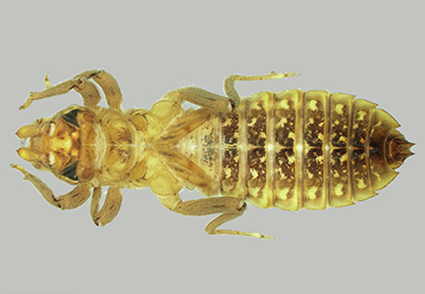Abstract
The larva of Epigomphus sulcatistyla Donnelly, 1989 is described, figured and compared with other described Mexican larvae. It is characterized by 3rd antennomere spindle-shaped, almost twice longer than its widest part; ligula with a ventral row of eight short, truncate teeth on middle; abdomen lateral spines on S7–9 slightly divergent; male epiproct dorsal tubercles rounded apically and divergent distally. It differs from other Mexican species mainly in shape of 3rd antennomere, number of teeth on ligula, serrations on lateral margins of S8–9, and shape of cerci. Also, the hitherto unknown female is described, for the first time, based on four teneral female from reared larvae.
References
- Calvert, P.P. (1903) On some American gomphinae (Odonata). Entomological News, 14, 183−192.
- Calvert, P.P. (1920) The Costa Rican species of Epigomphus and their mutual mating adaptations (Odonata). Transactions of the American Entomological Society, 46, 323−354.
- Corbet, P.S. (1953) A terminology for the labium of larval Odonata. The Entomologist, 86, 191−196.
- Donnelly, T.W. (1989) Three new species of Epigomphus from Belize and Mexico (Odonata: Gomphidae). Florida Entomologist, 72 (3), 428−435. https://doi.org/10.2307/3495179
- Fleck, G. (2002) Contribution à la connaissance des Odonates de Guyane française: notes sur les genres Epigomphus Hagen, 1854, et Phyllocycla Calvert, 1948 (Anisoptera, Gomphidae). Bulletin de la Société entomologique de France, 107, 493−501. https://doi.org/10.3406/bsef.2002.16896
- González-Soriano, E. & Cook, C. (1988) Una nueva especie de Epigomphus Selys, 1854 (Odonata: Gomphidae) del estado de Veracruz, México. Folia Entomológica Mexicana, 74, 5−12.
- González-Soriano, E. & Novelo-Gutiérrez, R. (2007) Odonata of Mexico revisited. In: Tyagi, B.K. (Ed.), Odonata: biology of dragonflies. Scientific Publishers, Jodhpur, pp. 105−136.
- Haber, W.A. (2017) Three new species of Epigomphus (Odonata: Gomphidae) from Costa Rica. Zootaxa, 4282 (1), 73–94. https://doi.org/10.11646/zootaxa.4282.1.4
- Kennedy, C.H. (1936) Epigomphus crepidus a new dragonfly (Odonata: Gomphidae) from Nayarit, Mexico, with notes on the genus. Annals of the Entomological Society of America, 29 (1), 126−135. https://doi.org/10.1093/aesa/29.1.126
- Martins, J.P. (1968) Contribução ao conhecimento da fauna da Guanabara, 59. Notas sôbre a ninfa de Epigomphus paludosus Hagen in Selys, 1854 (Odonata, Gomphidae). Atas da Sociedade de Biologia do Rio de Janeiro, 11, 157−158.
- Novelo-Gutiérrez, R., Gómez-Anaya, J.A. & Smith-Gómez, S.A. (2015) Description of the larva of Epigomphus crepidus Kennedy, 1936 (Odonata: Gomphidae). Zootaxa, 4027 (4), 587–592. https://doi.org/10.11646/zootaxa.4027.4.8
- Novelo-Gutiérrez, R., Ramírez, A. & Delgado, D. (2016) The larvae of Epigomphus jannyae Belle, 1993 and E. tumefactus Calvert, 1903 (Insecta: Odonata: Gomphidae). Peer J, 4, e2338. https://doi.org/10.7717/peerj.2338
- Paulson, D., Schorr, M., Abbott, J., Bota-Sierra, C., Deliry, C., Dijkstra, K.-D. & Lozano, F. (Coords.) (2024) World Odonata List. OdonataCentral, University of Alabama, Tuscaloosa, Alabama. Available from: https://www.odonatacentral.org/app/#/wol/ (accessed 15 January 2024)
- Ramírez, A. (1996) Six new dragonfly larvae of the family Gomphidae in Costa Rica, with a key to the Central American genera (Anisoptera). Odonatologica, 25, 143−156.
- Watson, M.C. (1956) The utilization of mandibular armature in taxonomic studies of anisopterous nymphs. Transactions of the American Entomological Society, 81, 155−205.


